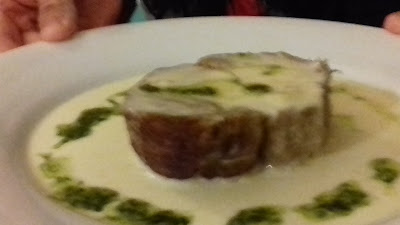
One of my great joys of living in Lyon in January and half of February was to walk along the Rhône River on my way to and from school. One section of the river was graced with platanes, the beautiful white trees planted in Lyon's parks and lining its major streets. As I walked I would prepare for class by doing practice warm ups in French. This included reading street and store signs in French, which helped me articulate the sounds as well as forcing myself to express my thoughts in French instead of English.

Next to the walkway among the trees is a lower walkway. Bicyclists and joggers seem to like it because it is safe from cars. On Sundays and holidays, families typically stroll here.
The riverfront is also lined with tourist boats securely moored during the winter months. When the weather is nice, the boats offer cruises with food, music, and stunning views.

This view of the Rhône shows the Lafayette Bridge and the 17th century buildings built on the riverfront. I crossed this bridge almost every day on my 45-minute walk to school. In the background (center-left) above the buildings is a white, castel-like structure. That's the Basilica on Fourvière Hill. It was built in 1872-84. Although it's difficult to see in this photo, to the left of the Basilica is a small chapel where Mother St. John Fontbonne used to go every day to pray for the sisters she sent to America. On my way to school I'd look up at that chapel as one of her daughters and pray to her for help with my French.

This is a view of the Rhône moving downstream toward the Confluence with the Saône.
The city uses its two rivers, the Rhône and the Saône, to make Lyon a more beautiful and welcoming gathering place for residents and tourists alike. That includes creating places for people to sit. In warmer weather, these steps are lined with people.
The towers in the background (left) provide lights for the swimming pool below.
Some background on the Rhône
 The Rhône's 500-mile journey begins with the Rhône glacier located near Oberwald in the Swiss Alps--altitude 7,244 feet. It flows southwest through Geneva and later through Lyon where it meets its major tributary, the Saône River. It then goes due south through Avignon and finally through Arles where it forms a delta and empties into the Mediterranean Sea. In French, the Rhône is called a fleuve because it flows into the sea. The Saône, on the other hand, is a rivière because it is a tributary and flows into a fleuve.
The Rhône's 500-mile journey begins with the Rhône glacier located near Oberwald in the Swiss Alps--altitude 7,244 feet. It flows southwest through Geneva and later through Lyon where it meets its major tributary, the Saône River. It then goes due south through Avignon and finally through Arles where it forms a delta and empties into the Mediterranean Sea. In French, the Rhône is called a fleuve because it flows into the sea. The Saône, on the other hand, is a rivière because it is a tributary and flows into a fleuve.  The Rhône has been an important transportation route since the ancient Greeks and Romans. Before modern railroads and freeways, the Rhône continued to be an inland trade highway.
The Rhône has been an important transportation route since the ancient Greeks and Romans. Before modern railroads and freeways, the Rhône continued to be an inland trade highway.Traveling down the Rhône by barge would take three weeks. Now, with motorized vessels, it takes only three days.

The Rhone at Night

I didn't go out much at night, but one night I did and I discovered a whole new world. The Rhône was a magnificent sight as street lights reflected on its waters. The river also seemed to be at its calmest quite a contrast to its daytime rush downstream. And, although winter temperatures in Lyon are in the 40s, people are constantly out walking along the river. Night time is no exception.
This photo above shows the river upstream with the Lafayette Bridge in the background. Below is a photo looking downstream at the Wilson Bridge.

 Behind this riverfront is the huge pedestrian shopping center that runs several blocks along Rue de la République from the Hôtel de Ville (city hall) to Place Bellecour, one of Europe's largest open squares; it measures 15 acres! There was a Ferris wheel there and next to it a churro stand (fried dough). It seemed odd that there were not other rides, however, the wheel gave stunning views of the city along the riverfront. Maybe that was the reason it was there. It also helped me find my way whenever I need to orient myself. I could see the Ferris wheel at the end of the street where I lived.
Behind this riverfront is the huge pedestrian shopping center that runs several blocks along Rue de la République from the Hôtel de Ville (city hall) to Place Bellecour, one of Europe's largest open squares; it measures 15 acres! There was a Ferris wheel there and next to it a churro stand (fried dough). It seemed odd that there were not other rides, however, the wheel gave stunning views of the city along the riverfront. Maybe that was the reason it was there. It also helped me find my way whenever I need to orient myself. I could see the Ferris wheel at the end of the street where I lived.The Rhône at Flood Stage
One day the evening news announced that avalanches were occurring in the Alps. We certainly could see their effects on the Rhône as it passed through Lyon. In these photos below, the lower walkway was flooded. City workers put up barricades to prevent people from going into these areas. Meanwhile, people stood on the bridges with their cameras to record the flooding.
The parking lot along the river and under the main street was totally flooded. I estimate that the river rose 8-12 feet! Clearly, this flooding was a clear reminder that whatever happens upstream affects those places downstream!
What the Rhône Meant to Me
Walking along the Rhône each day became a highlight as well as an opportunity to observe its daily changes. Gradually, I began to relate to the river and even personify it.
One day after nearly four weeks of French lessons, I walked home feeling frustrated and depressed wondering if I were ever going to learn the language? My speaking abilities seemed to be degenerating, and I wasn't sure how much spoken French I really understood. My reading of French had improved greatly, but I couldn't recall the words whenever I tried to use them; I only remembered that I had studied them. As I passed by the Rhône on my way home from class, I stopped and asked it to help me. There was no answer.
I told the sisters I lived with about my asking the river for help and was surprised when they suggested that I give it some time to speak to me. That night I had dreams and awoke with a stream of ideas about learning French. The river had opened my understanding about why I was so stressed about it. As I walked along the Rhône the next day, I felt quite uplifted in the belief that the Rhône had indeed spoken to me. Then I got another answer from it as I passed the sculpture on the Bourse building. The sculpture shows the Confluence of the Rhône and Saône as lovers: the Rhône is the man and the Saône is the woman.
 Artists have oftentimes personified Nature. The ancient gods and goddesses are depictions of Nature! Artists have also personified the Rhône. Here is one by Pierre Puvis de Chavannes (1883-86).
Artists have oftentimes personified Nature. The ancient gods and goddesses are depictions of Nature! Artists have also personified the Rhône. Here is one by Pierre Puvis de Chavannes (1883-86).My favorite, however, will always be the small sculpture outside the Bourse building on Rue de la République in Lyon.














